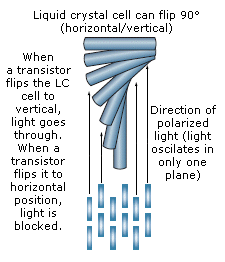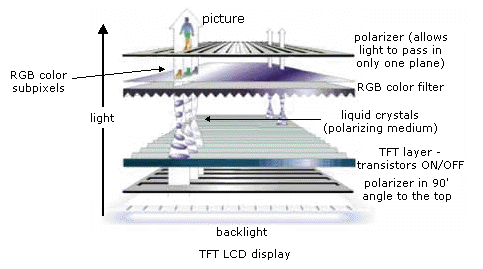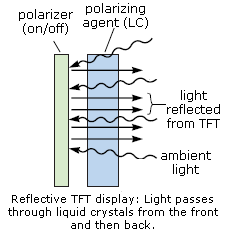TFT LCD display or monitor
TFT LCD display or monitor
TFT stands for Thin-Film Transistor. TFT technology is a new standard these days for manufacturing displays, monitors, laptop screens, and other devices. TFT LCD displays can show crisp text, vivid colors, fast animations, and complex graphics.
TFT LCD monitors, also called flat panel displays, are replacing the old style cathode ray tubes (CRTs) as the displays of choice. Almost all LCD monitors today take advantage of the TFT technology.
What are the benefits of a TFT display?
Each pixel on a TFT display is backed by a tiny transistor. Transistors are so small these days, they need only a very minimal charge to control what they do. TFT displays are much more energy efficient than regular CRT screens that need a powerful light source.
TFT displays also allow for very fast re-drawing of the display, so the image has very little chance to flicker. This was not always the case with flat-panel monitors. Original passive matrix LCD displays were not able to refresh at very high rates and therefore could not keep up with fast moving images. A TFT monitor refresh rate is very high resulting in a display that can be used for video, gaming, and all forms of multimedia.
A TFT monitor delivers crisp text, vibrant colors, and an improved response time for multimedia applications. Today's standard for response rate in TFT monitors is 16 ms or less.
How does TFT display work?
Let us start with explanation how a LCD display, a predecessor to TFT LCD, works.
In general, a LCD display comprises of a layer of LCD material and one or more polarizing layers made of plastic, glass, or some other material. A LCD display has a sandwich-like structure with liquid crystals filled between two glass (or plastic or polycarbonate) plates.
A LCD display shows a picture through millions of tiny picture elements called pixels. You can understand a pixel as a tiny dot on your screen.
Pixels are formed by liquid-crystal cells that change the direction of light passing through them in response to an electrical voltage.
These liquid crystals when stimulated by an external electrical charge can change the properties of light passing through them. When you align two polarizing materials with each other, light passes through. When you align one polarizing agent at a 90° angle to the other, light is blocked. Change the voltage, and the amount of light passing through the display is changed.

Liquid crystals in LCD monitor act as a dynamic polarizing agent. They change their orientation when you place a voltage across an LCD cell. The orientation of the polarizing agent under the LCD layer either blocks or passes light.
So, where does a TFT come into the game?
A TFT display is an advanced LCD display. A TFT monitor uses so-called thin-film transistor technology to project a picture on the screen. Transistors in a TFT display are used to change the orientation of the polarizing agent. A typical 17-inch TFT monitor has about 1.3 million pixels and 1.3 million transistors. The following text explains TFT in a greater detail...Active or passive LCD?
When you look at a passive-LCD technology, the cells act as capacitors. When you charge a cell, the liquid crystal flips to one position. When you stop supplying charge to the cell, it voluntarily bleeds off its voltage and the liquid crystal slowly twists back to its original position.
Passive LCD panels cannot quickly change the orientation of the crystal. Well, it is quick, but not quick enough to display fast-moving graphics. To overcome this slowness, engineers came up with active-LCD technology. Active-LCD displays use transistors to actively change the orientation of crystals. That is where TFT comes from. T in TFT for transistor. This method allows for faster control of the LCD cell but is also more complex.

While passive-LCD displays start to blur with images moving faster than 8 to 15 frames/sec, TFT displays can display full-motion video and graphics because they use fast switching transistors.
How is color displayed in a TFT monitor?
Now that we know how a LCD works and what it behind TFT, we can start talking about color. Each pixel in a color TFT LCD is subdivided into three subpixels. One of the subpixels is capable of producing red, the other one green, and the last one blue color. Red, green, and blue are the basic colors. Any other color can be produced by mixing up these three. One set of RGB subpixels is equal to one pixel.
Because the subpixels are super tiny for the human eye to see them individually, the three RGB elements appear to the human eye as a mixture of the three colors. Any color can be produced by mixing these three primary colors.
Where does the light in a TFT LCD panel come from?
Old TFT displays and the small ones in simple applications such as calculators are reflective TFT. A reflective TFT display has no backlight. The polarizing agent at the rear of the TFT display is simply a mirror layer behind the TFT panel. The agent merely reflects incoming light from the front of the display. You need to be in a well-lit room to be able to read this type of display.

The next step in a TFT LCD design was to add a light source to it. More advanced TFT displays have added sidelights or front lights to these displays. Sidelights and front lights are virtually the same as backlights. The difference is just the position of the light. Front lights sit on the side or slightly in front of the TFT layers. They are designed so that the light they produce shines through the TFT panel and bounces off the reflective polarizing agent back through the display.
A transmissive TFT uses a backlight. Most TFT LCD panels today are designed with a backlight. The source of the light is mounted at the rear side of the LCD panel and shines light towards your eyes through the TFT panel's polarizing medium (liquid crystal). Small displays, such as cell phones or calculators, use light source that is placed along the sides of the display.

The common TFT-display backlight is the CCFL (cold-cathode fluorescent lamp). CCFLs are similar to fluorescent light tubes that you commonly find in offices and homes. Their advantage is that they are small, inexpensive, replaceable, and cheap.
If the TFT display has its own light, why can't I see anything on the display on a sunny day?
The polarizing medium in a TFT that transmits or blocks the backlight is clear, so any light shining on the display from the front competes with the backlight. If the light source shining on the front of the TFT display is strong enough, such as sun on a sunny day, it simply overpowers your laptop TFT display's backlight and the display image is washed out. A reflective TFT display is usually a better choice for applications with high ambient light.
What is LED backlighting in a TFT LCD display?
If you shop for a laptop these days, the better ones come with LED backlight. In this case, the source of light comes from LEDs instead of from CCFL.
LED technology has only recently achieved the white light necessary to illuminate these panels. LEDs are the choice these days because they are stable over temperature ranges, durable, and very energy efficient. That is why if you buy a laptop with a TFT LED back-lighted display, it is possible that it will go for as much as 8 hours with your battery.
What else?
Perhaps you might be interested in some reading about LightScribe, ExpressCard, or USB 3.0 (Need for speed).
It is easy, just include the code provided below into your HTML code.
 Delicious
Delicious Digg
Digg StumbleUpon
StumbleUpon Furl
Furl Facebook
Facebook Google
Google Yahoo
Yahoo

